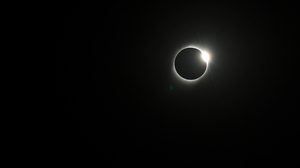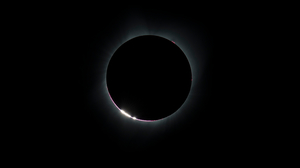| | Partial eclipse beginsThe moment the edge of the Moon touches the edge of the Sun is called first contact. | | |
| | Totality beginsThe moment the edge of the Moon covers all of the Sun is called second contact. | | |
| | Maximum eclipseThe deepest point of the eclipse, with the Sun at its most hidden. | | |
| | Totality endsThe moment the edge of the Moon exposes the Sun is called third contact. | | |
| | Partial eclipse endsThe edge of the Moon leaves the edge of the Sun. | | |
| | Dark shadow on horizonThe Moonās umbral shadow may become visible as it approaches from the west. | | |
| | Corona appearsThe coronaāthe outer part of the Sunās atmosphereāstarts to become visible. | | |
| | Dark shadow sweeps inThe Moonās umbral shadow arrives from the west and envelops the surroundings. | | |
| | Diamond ringThe corona forms a ring around the dark Moon, while the Sun dazzles like a jewel. | | |
| | Bailyās beadsJust before totality, beads of sunlight stream through valleys along the edge of the Moon. | | |
| | Bailyās beadsJust before annularity, beads of sunlight stream through valleys along the edge of the Moon. | | |
| | Annularity beginsThe moment the Sun forms a ring around the Moon is called second contact. | | |
| | Ring of fireThe Sun shines as a dazzling annulus (a ring shape) around the Moon. | | |
| | ChromosphereThe chromosphereāa thin, red layer of the Sunās atmosphereāis briefly visible. | | |
| | ProminencesReddish, tounge-like prominences may poke out from the Sun during totality. | | |
| | CoronaDuring totality, the ghostly corona shines as brightly as a Full Moon. | | |
| | ChromosphereJust before the end of totality, the chromosphere briefly reappears. | | |
| | Annularity endsThe moment the Sunās ring around the Moon is broken is called third contact. | | |
| | Baily's beadsA new set of Bailyās beads appears, signalling the end of annularity. | | |
| | Bailyās beadsA new set of Bailyās beads appears, signalling the end of totality. | | |
| | Diamond ringBailyās beads come together to form another dazzling jewel of sunlight. | | |
| | Dark shadow sweeps outThe Moonās umbral shadow departs toward the east. | | |
| | Corona fadesThe ring of the corona around the Moon disappears from view. | | |
| | Dark shadow on horizonThe Moonās umbral shadow may be visible in the distance as it retreats to the east. | | |
| | Maximum eclipseThe deepest point of the eclipse, with the Sun at its most hidden. | | |
| | Maximum eclipseThe deepest point of the eclipse, with the Sun at its most hidden. | | |
| | Partial eclipse beginsThe moment the edge of the Moon touches the edge of the Sun is called first contact. | | |
| | Partial eclipse beginsThe moment the edge of the Moon touches the edge of the Sun is called first contact. | | |
| | Partial eclipse endsThe moment the edge of the Moon leaves the edge of the Sun is called fourth contact. | | |
| | Partial eclipse endsThe moment the edge of the Moon leaves the edge of the Sun is called fourth contact. | | |
| | SunriseThe sun is rising. | | |
| | SunriseThe sun is rising. | | |
| | SunriseThe sun is rising. | | |
| | SunsetThe sun is setting. | | |
| | SunsetThe sun is setting. | | |
| | SunsetThe sun is setting. | | |
| | Temperature changesAs the Moon covers the Sun, the amount of solar energy decreases. | | |
| | Temperature changesAs the Moon covers the Sun, the amount of solar energy decreases. | | |
| | Temperature changesAs the Moon covers the Sun, the amount of solar energy decreases. | | |
| | Sharp & blurry shadowsShadow edges that are aligned with the Sunās narrowing crescent become sharper. | | |
| | Sharp & blurry shadowsShadow edges that are aligned with the Sunās narrowing crescent become sharper. | | |
| | Sharp & blurry shadowsShadow edges that are aligned with the Sunās narrowing crescent become sharper. | | |
| | Brightness of skyAs the eclipse progresses, the sky starts to become noticeably darker. | | |
| | Brightness of skyAs the eclipse progresses, the sky starts to become noticeably darker. | | |
| | Brightness of skyAs the eclipse progresses, the sky starts to become noticeably darker. | | |
| | Temperature, humidity & windConditions continue to change as the amount of solar energy decreases. | | |
| | Temperature, humidity & windConditions continue to change as the amount of solar energy decreases. | | |
| | Temperature, humidity & windConditions continue to change as the amount of solar energy decreases. | | |
| | Light levels & colorsSurroundings start to darken, while colors start to turn grayish. | | |
| | Light levels & colorsSurroundings start to darken, while colors start to turn grayish. | | |
| | Light levels & colorsSurroundings start to darken, while colors start to turn grayish. | | |
| | Reaction of natureThe behavior of animals and plants starts to be affected by falling levels of light. | | |
| | Reaction of natureThe behavior of animals and plants starts to be affected by falling levels of light. | | |
| | Reaction of natureThe behavior of animals and plants starts to be affected by falling levels of light. | | |
| | Shadow bandsFaint waves of light may be seen moving across the ground and walls. | | |
| | Nature returns to normalAnimals and plants are going back to their usual behavior. | | |
| | Nature returns to normalAnimals and plants are going back to their usual behavior. | | |
| | Nature returns to normalAnimals and plants are going back to their usual behavior. | | |
| | Light levels & temperatureThe conditions of the sky and surroundings are returning to normal. | | |
| | Light levels & temperatureThe conditions of the sky and surroundings are returning to normal. | | |
| | Light levels & temperatureThe conditions of the sky and surroundings are returning to normal. | | |
| | Shadow bandsFaint waves of light may reappear along the ground and walls. | | |
| | Moon bites SunUsing eclipse glasses, the eclipse starts to become visible to the eye. | | |
| | Moon bites SunUsing eclipse glasses, the eclipse starts to become visible to the eye. | | |
| | Moon bites SunUsing eclipse glasses, the eclipse starts to become visible to the eye. | | |
| | Obscuration around 20%One-fifth of the area of the Sunās disk is covered by the Moon. | | |
| | Obscuration around 20%One-fifth of the area of the Sunās disk is covered by the Moon. | | |
| | Obscuration around 20%One-fifth of the area of the Sunās disk is covered by the Moon. | | |
| | Obscuration around 20%One-fifth of the area of the Sunās disk is covered by the Moon. | | |
| | Obscuration around 20%One-fifth of the area of the Sunās disk is covered by the Moon. | | |
| | Obscuration around 20%One-fifth of the area of the Sunās disk is covered by the Moon. | | |










